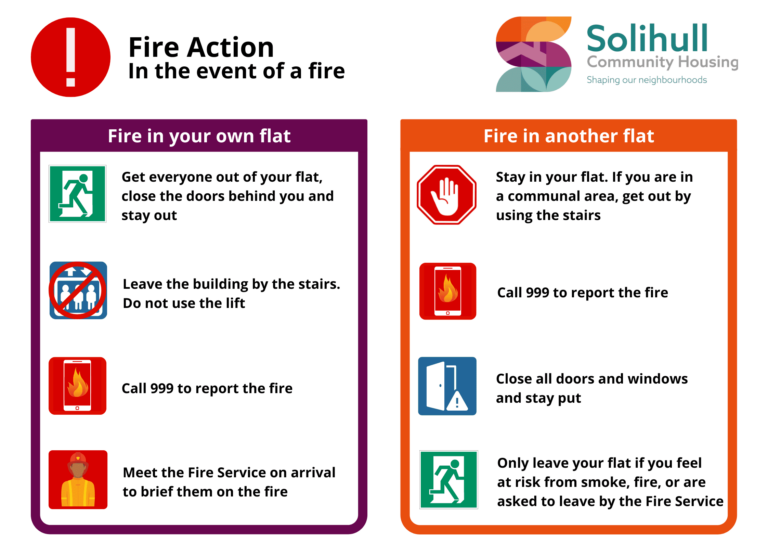When a fire breaks out, knowing what to do can mean the difference between life and death. Understanding the proper actions to take in the event of a fire is crucial for everyone’s safety. This blog will guide you through essential steps and best practices to “Stay Safe: What to Do in the Event of a Fire.” From creating and practicing a fire escape plan to using fire extinguishers effectively, we will cover it all. Stay informed on how to act swiftly, stay calm, and protect yourself and your loved ones during a fire emergency. Let’s delve into the vital information on what you should do if a fire occurs.
Understanding Fire Safety Basics
When facing a fire emergency, it is crucial to know what to do in the event of a fire. Understanding the basics of fire safety can save lives and minimize property damage.
Importance of Fire Alarms
Fire alarms play a critical role in alerting individuals to the presence of a fire. Regularly test your alarms to ensure they are functioning correctly.
Creating an Escape Plan
Developing an escape plan is essential for every household or workplace. Identify primary and secondary escape routes to evacuate safely.
- Practice the escape plan with all household members or employees.
- Designate a meeting point outside to ensure everyone is accounted for.
- Keep escape routes clear of obstacles for quick evacuation.

Creating an Emergency Escape Plan
In the event of a fire, having a well-thought-out emergency escape plan is crucial for the safety of you and your loved ones. Here are some key steps to help you create an effective escape plan:
Identify Escape Routes
Start by identifying all possible escape routes from each room in your home. Make sure to have at least two exits per room, such as doors and windows. Remember, different scenarios may require different routes.
Designate a Meeting Point
Choose a designated meeting point a safe distance away from your home, such as a neighbor’s house or a specific tree. This will help ensure that everyone is safely outside and accoounted for.
Practice Regularly
Regularly practice your escape plan with all members of your household, including children and pets. Repetition instills the plan in everyone’s mind, ensuring a quick and efficient response during an emergency.
Identifying Fire Hazards in Your Home
As part of fire safety preparedness, it is crucial to identify potential fire hazards within your home. Conducting regular assessments and taking preventive measures can significantly reduce the risk of a fire incident.
Common Fire Hazards
- Electrical Malfunctions: Outdated wiring, overloaded outlets, and damaged cords can pose a serious fire hazard.
- Flammable Materials: Keep flammable items such as chemicals, aerosols, and towels away from heat sources.
- Clutter: Excessive clutter can obstruct escape routes and fuel fires.
Preventive Measures
It is essential to take proactive steps to mitigate fire risks:
- Install smoke detectors in every room for early detection.
- Keep a fire extinguisher with easy access on every floor.
- Regularly maintain heating systems and electrical appliances.
Practicing Fire Prevention Techniques
Practicing fire prevention techniques is crucial to ensure the safety of your loved ones and property in case of an emergency. By following these simple yet effective steps, you can significantly reduce the risk of a fire outbreak.
Awareness and Education
Stay informed on fire safety protocols and educate your family on what to do in the event of a fire. Conduct regular fire drills to practice evacuation procedures and ensure everyone knows the escape routes.
**Make sure to test the smoke alarms regularly and keep a fire extinguisher handy at home.**
Maintain Electrical Appliances
**Regularly inspect electrical cords and replace any frayed wires immediately. Avoid overloading electrical outlets** and unplug appliances when not in use to prevent electrical fires.
**Consider hiring a professional electrician to evaluate your home’s electrical system for any potential hazards.**
Kitchen Safety
**Never leave cooking unattended and keep flammable objects away from the stove**. In case of a grease fire, **never use water to extinguish it**; instead, cover the pan with a lid and turn off the heat.
- **Teach children to stay away from hot surfaces, and keep matches and lighters out of their reach.**
Reacting Quickly in Case of a Fire
During a fire emergency, it is crucial to act swiftly and decisively. Here are some essential steps to follow to ensure your safety:
Evacuate Immediately
If you discover a fire or hear the fire alarm, leave the building without delay. Do not waste time gathering belongings or investigating the source.
Ensure to crawl low under smoke for cleaner air for better breathing.
Alert Others
While evacuating, inform others by shouting “Fire!” to alert them of the danger and prompt them to evacuate as well.
- Check rooms for individuals who may not be aware of the fire.
- Assist children and elderly individuals in escaping to safety.

Using Fire Safety Equipment Effectively
When faced with a fire emergency, it is crucial to know what to do in the event of a fire. Using fire safety equipment effectively can make a significant difference in minimizing damages and ensuring the safety of individuals. One vital aspect of fire safety is the proper utilization of fire extinguishers, fire blankets, and fire alarms.
Understanding Fire Extinguishers
Fire extinguishers are essential tools in combating small fires. It is crucial to know the types of extinguishers and the appropriate Class of fire they can be used on. Remember the P.A.S.S. technique: Pull, Aim, Squeeze, Sweep when operating a fire extinguisher.
Utilizing Fire Blankets
Fire blankets are effective in smothering fires involving people’s clothing or small household fires. When using a fire blanket, ensure to fully cover the flames to cut off the oxygen supply. Additionally, wrap the blanket around your hands for protection while approaching the fire.
Responding to Fire Alarms
Fire alarms are early warning systems that can help alert individuals to evacuate swiftly during a fire. Perform regular checks on fire alarms to ensure functionality. Familiarize yourself and others with the evacuation route and assembly points to maximize safety.
Seeking Help and Evacuating Safely
In an emergency such as a fire, it is crucial to seek help and evacuate safely. The first step is to immediately notify the authorities by calling the emergency services on 911 or the local fire department. Remain calm and provide them with accurate information about the fire’s location and severity.
Guiding Others to Safety
If you are in a position to help others evacuate, do so cautiously. Guide them to safety by using the designated evacuation routes if available. Keep communication clear and encourage everyone to stay together for visibility and safety.
Emergency Kit Preparation
Having an emergency kit ready can aid in a swift evacuation. Include essentials like water, flashlights, first aid supplies, and any necessary medications. Ensure your kit is easily accessible and up to date with supplies that can last for at least 72 hours.
Frequently Asked Questions
-
- What should I do if there is a fire?
- In the event of a fire, stay calm and act quickly. Immediately alert others, evacuate the building following the established escape routes, and call the fire department.
-
- How can I protect myself from smoke during a fire?
- If you encounter smoke during a fire, stay low to the ground where the air is clearer. Cover your nose and mouth with a wet cloth to reduce inhalation of smoke.
-
- Should I use elevators during a fire?
- No, avoid using elevators during a fire. Use the stairs to evacuate the building safely as elevators may malfunction or trap you during a fire.
-
- What should I do if I am unable to escape a building during a fire?
- If you are unable to escape a building during a fire, move to a room with a window, close the door, and signal for help by waving a cloth or shining a light out of the window. Stay low if possible to avoid smoke.
-
- How can I prepare for a fire emergency?
- Be prepared for a fire emergency by installing smoke alarms in your home, creating a fire evacuation plan with your family, and practicing fire drills regularly. Keep fire extinguishers in accessible locations.
Final Thoughts on What to Do in the Event of a Fire
As we conclude our discussion on what to do in the event of a fire, it is crucial to remember the key takeaways to ensure your safety and the safety of others in such emergencies. Firstly, remain calm and act quickly by following the fire evacuation procedures. Secondly, prioritize your safety by evacuating the building immediately and using designated exit routes. Thirdly, never underestimate the importance of smoke alarms and fire drills in preventing and preparing for fires. Remember, preparedness is key in the face of any emergency situation. Stay informed, stay alert, and most importantly, stay safe!

